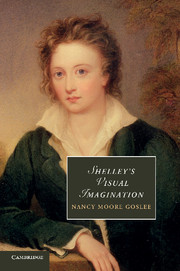Book contents
- Frontmatter
- Contents
- List of illustrations
- Acknowledgments
- 1 Introduction: text and figure
- 2 Mab's metamorphoses
- 3 “Hymn to Intellectual Beauty”: visual texts, invisible figure
- 4 “Clear elemental shapes”: communicating Greek liberty in Laon and Cythna
- 5 Anarchy's textual progress: representing liberty
- 6 Refiguring genre in Shelley's “Ode to Liberty”
- 7 Dispersoning Emily: drafting as plot in Epipsychidion
- 8 “Compelling / All new successions”: death and the poet's figurations in Adonais
- 9 The Triumph of Life: figure, history, and inscription
- Notes
- Bibliography
- Index
- CAMBRIDGE STUDIES IN ROMANTICISM
5 - Anarchy's textual progress: representing liberty
Published online by Cambridge University Press: 05 March 2014
- Frontmatter
- Contents
- List of illustrations
- Acknowledgments
- 1 Introduction: text and figure
- 2 Mab's metamorphoses
- 3 “Hymn to Intellectual Beauty”: visual texts, invisible figure
- 4 “Clear elemental shapes”: communicating Greek liberty in Laon and Cythna
- 5 Anarchy's textual progress: representing liberty
- 6 Refiguring genre in Shelley's “Ode to Liberty”
- 7 Dispersoning Emily: drafting as plot in Epipsychidion
- 8 “Compelling / All new successions”: death and the poet's figurations in Adonais
- 9 The Triumph of Life: figure, history, and inscription
- Notes
- Bibliography
- Index
- CAMBRIDGE STUDIES IN ROMANTICISM
Summary
As the English critical establishment mobilized its responses to The Revolt of Islam, Shelley left for Italy in pursuit of that immersion in classical culture he had described for his fictional Greek revolutionaries Laon and Cythna. His travel, his translations of Plato, and his return to the reading of Aeschylus that he had begun with Byron in 1816 bore fruit in his complex “lyrical drama” Prometheus Unbound, begun in late August 1818 and finished – or so he thought – in the late spring of 1819. Because he adapts classical myth to frame this prophetic drama set in the near future, employing a sort of allegoresis to reinterpret both Aeschylus' and Milton's narratives of resistance to tyranny, he turns away for the most part from allegorical personification. Yet his dramaturgy of evanescent visionary figures and voices that attempt to interpret those visions continues his exploration of how thought, sight, and speech intersect and challenge one another. After pursuing some of the same themes in his more realistic and more pessimistic drama The Cenci, Shelley decided in August to add a fourth, more apocalyptic act to Prometheus. That project was interrupted by the news of Peterloo. In response, he redirected his prophetic and apocalyptic impulses into a more popular mode, one that grounds the problems of resistance to tyranny on English soil and one that adapts the rhetoric of allegorical personification he had honed in Laon and Cythna.
- Type
- Chapter
- Information
- Shelley's Visual Imagination , pp. 95 - 122Publisher: Cambridge University PressPrint publication year: 2011

